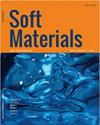具有混合醚链的C3对称辉石盘状液晶:合成、介晶性和自组装性质
IF 1.4
4区 材料科学
Q4 MATERIALS SCIENCE, MULTIDISCIPLINARY
引用次数: 1
摘要
摘要合成了9种新的C3对称的2,7,12-三(癸氧基)-3,8,13-三(烷氧基)辉石盘状物,通过偏光显微镜、差示扫描量热法和X射线衍射法对其进行了表征,发现它们都只表现出一个宽介晶温度范围的三维有序六方柱状中间相。至关重要的是,随着烷氧基链长度的增加,熔点先增加后降低,同时清除点的温度逐渐降低。此外,通过热重分析,发现这些化合物具有高度的热稳定性,分解温度远高于350°C。使用可变浓度的1H-NMR研究了溶液中的自组装行为,揭示了松石通过多环芳香单元的π–π面相互作用在溶液中自聚集,扫描隧道显微镜结果表明,其中一种盘状液晶化合物在高取向热解石墨的液固界面周期性地组装成六边形。本文章由计算机程序翻译,如有差异,请以英文原文为准。
C 3-symmetric truxene discotic liquid crystals with mixed ether chains: synthesis, mesomorphism, and self-assembly properties
ABSTRACT Nine new C3-symmetric 2,7,12-tris(decanoxy)-3,8,13-tris(alkoxy)truxene discogens were synthesized, and all exhibited only one three-dimensionally ordered hexagonal columnar mesophase with a wide mesogenic temperature range, as characterized by polarizing optical microscopy, differential scanning calorimetry, and X-ray diffractometry. Crucially, as the length of the alkoxy chain increased, the melting points first increased and then decreased, and, at the same time, the temperatures of the clearing point decreased gradually. In addition, these compounds were found to be highly thermally stable, having decomposition temperatures occurring well above 350°C, as determined by thermogravimetric analysis. The self-assembly behaviors in solution were studied using variable-concentration 1H-NMR, revealing that the truxenes self-aggregated in solution via the π–π facial interactions of the polycyclic aromatic units, and scanning tunneling microscopy results revealed that one of the discotic liquid crystal compounds periodically assembled in a hexagonal geometry at the liquid–solid interface of highly oriented pyrolytic graphite.
求助全文
通过发布文献求助,成功后即可免费获取论文全文。
去求助
来源期刊

Soft Materials
工程技术-材料科学:综合
CiteScore
2.90
自引率
0.00%
发文量
21
审稿时长
2.2 months
期刊介绍:
Providing a common forum for all soft matter scientists, Soft Materials covers theory, simulation, and experimental research in this rapidly expanding and interdisciplinary field. As soft materials are often at the heart of modern technologies, soft matter science has implications and applications in many areas ranging from biology to engineering.
Unlike many journals which focus primarily on individual classes of materials or particular applications, Soft Materials draw on all physical, chemical, materials science, and biological aspects of soft matter. Featured topics include polymers, biomacromolecules, colloids, membranes, Langmuir-Blodgett films, liquid crystals, granular matter, soft interfaces, complex fluids, surfactants, gels, nanomaterials, self-organization, supramolecular science, molecular recognition, soft glasses, amphiphiles, foams, and active matter.
Truly international in scope, Soft Materials contains original research, invited reviews, in-depth technical tutorials, and book reviews.
 求助内容:
求助内容: 应助结果提醒方式:
应助结果提醒方式:


